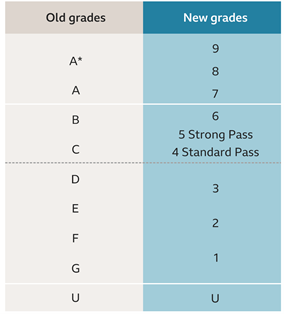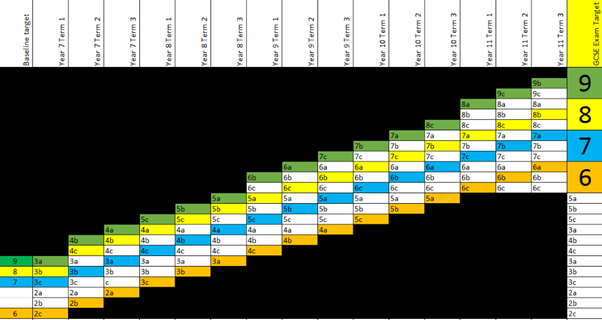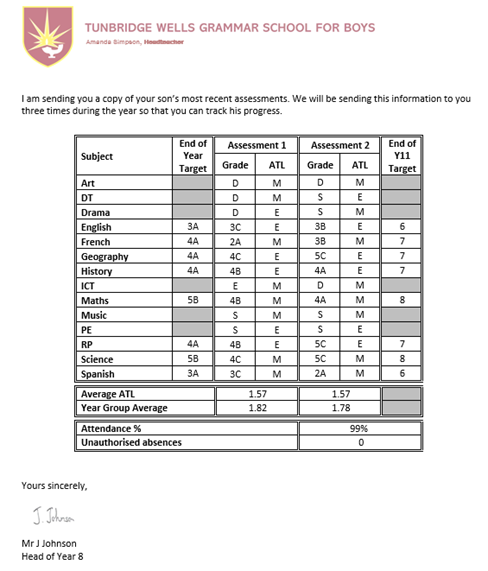- Home
- Curriculum and Exams
- Years 7 to 11
Years 7 to 11
How We Report Your Child’s Progress
 Target Grades
Target Grades
All students have a target grade, which is set based on their prior attainment at Key Stage 2. While all students do other benchmarking tests when they enter the school in Year 7 (CAT tests), the Department for Education measures their progress based on their end of KS2 scores. All students in Years 7–11 have a target GCSE grade of at least a grade 6 (the equivalent of a grade B in the old GCSE grading system).
A new GCSE grading system has been phased into use over the last four years. Since 2019 all GCSE subjects award grades using the numerical 9–1 grading system. This table gives a visual guide as to how the new grades compare to the old A*–G system.
In addition to their GCSE target grade, students in KS3 also have an end-of-year target grade (also a GCSE grade). This is based on a flightpath model, which is shown below. The primary aim of the flightpath model is to provide a general guide as to the appropriate level of progress at different points of each student's journey through the school.

All students entering the school in Year 7 are given a GCSE target grade ranging from grade 6 to 9 (generated by their performance at KS2). This determines their target for each year based on the flightpath model above.
For example, a student with a target of a grade 9 at the end of GCSE would be expected to be achieving a grade 4 by the end of Year 7, grade 5 by the end of Year 8 etc. These have been colour coded for ease of reference.
Please note that the flightpath is to be used only as a guide. There are certain subjects such as modern foreign languages (MFL) where the starting points from primary school may be very low. Consequently, the grades may be lower than the flightpath might suggest for an individual’s target for the year. Please note, a different grading system is used for the following subjects at KS3: PE, Drama, Music, IT, DT, Food Technology. Further details can be found below.
While it is not possible to reduce the end of Year 11 target grade to a grade lower than a 6, target grades may be raised to motivate particular individuals.
Data Reports
Parents receive an assessment letter at three assessment points (APs) each academic year. At each assessment point we will report a student’s academic attainment and progress and their attitude to learning (ATL) using the criteria outlined below.
AP attainment grades
An AP attainment grade is reported as a fine grade and corresponds to the flightpath table above for each year group. This shows the performance in each subject based on a student’s performance in their termly assessment and their academic performance across the term. Attainment grades provide a holistic assessment of a student’s academic progress in each subject rather than their performance in one assessment. Where students have completed mock examinations, these grades will be reported separately.
The fine grade element (A, B, C) is explained as follows:
- Excellent performance within this grade; likely to progress to the next grade soon;
- Secure performance within this grade;
- Insecure performance within this grade – this student may be at the bottom end of the grade boundary.
KS3 mastery grades
Rather than a GCSE-style grade being issued, Key Stage 3 students receive a mastery grade in Art, Drama, Music, Design Technology, Computing and PE. The mastery grade provides an overview of their progress in the subject throughout the academic year. Please note that these reset at the start of each year and are graded as follows:
| Mastery grade | Description |
| E – Emerging | The student is starting to establish the basic skills and knowledge required in the subject. |
| D – Developing | The student’s knowledge and skills have moved beyond the foundation level for the year and they are starting to demonstrate proficiency in the subject. |
| S – Secure | The student’s knowledge and skills have developed to a proficient level in the subject and they are working in line with expectations. |
| A – Advanced | The student’s knowledge and skills are above the expected level for their age group. |
Attitude to learning (ATL)
This encompasses all aspects of a student’s commitment to learning, both in and out of class, and is graded as follows:
| Attitude to learning (ATL) | Description |
| Below expectations (B) | Student regularly misses deadlines (both in and out of class); standards of organisation (bringing appropriate equipment, books etc.) and presentation are not met; quality/quantity of work is below the expected standard; there may be concerns about behaviour and punctuality (but not exclusively). |
| Meeting expectations (M) | Student meets the majority of deadlines; basic standards of organisation and presentation are met; quality of work is of a good standard and what would be expected of a grammar school student; behaviour and focus in lessons are consistently good, in line with the expected standard. |
| Exceeding expectations (E) | As with the above but work demonstrates effort that is clearly above and beyond that of their peers; contributions to class are insightful; behaviour is exemplary; student takes advantage of all additional opportunities (revision clinics etc.). |
Interpreting your child’s assessment letters
Parents/carers receive a formal letter at three points across the year which summarise their child’s attainment at each assessment point (AP). An example is shown below. At the end of each academic year, each child will also receive a written report from their Form Tutor.

Ongoing Assessment
The school’s assessment policy is that feedback should be given to students approximately every six lessons. This may be in the form of the following:
- Teacher feedback as evidenced by a red WWW (what went well)/EBI (‘Even better if…’) stamp;
- Self-assessment and peer assessment evident with a green stamp.
Students are expected to respond to any feedback given in green pen.